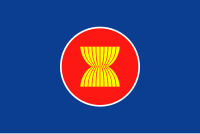ASEAN Free Trade Area
| Association of Southeast Asian Nations ASEAN |
|
|---|---|
 Member states of ASEAN |
|
| English name | ASEAN Free Trade Area |
| Seat of the organs | Jakarta , Indonesia |
| Secretary General | Lê Lương Minh |
| Member States | 10 : |
| surface | 4,480,000 km² |
| population | 634,485,000 (2016) |
| Population density | Inhabitants per km² |
| founding |
Bangkok Treaty |
| Currencies |
|
| anthem | ASEAN anthem |
| Time zone | UTC + 6 , UTC + 7 , UTC + 8 , UTC + 9 , UTC + 10 |
|
Gross National Income (GNP) (2003) Total: $ 2,172 trillion. (PPP) - $ 681 billion (nominal) GNP / capita: $ 4,044 (PPP) - $ 1,267 (nominal) |
|
The ASEAN Free Trade Area (AFTA) , from engl. ASEAN Free Trade Area , is an agreement between the ASEAN states that aims to facilitate economic cooperation in a free trade area.
- AFTA's goals are
- The improvement of the economic basis in the world market by lowering the tariff barriers among the members.
- Increasing the attractiveness of the economic area for foreign investors .
With a population of over 590 million people, ASEAN is larger than the European Union . This opens up the potential of a growing and integrated market for companies.
Regulations
The customs barriers are to be completely dismantled. Member States have the right to exempt certain cases:
- delicate agricultural products
- temporary suspensions
- general suspensions (ASEAN 2004)
The regulations now affect 98% of all customs duties in the ASEAN countries.
history
The first proposal for AFTA was made by then Prime Minister of Thailand, Anand Panyarachun , in September 1991. This proposal was adopted with additions during the meeting of the heads of government of the ASEAN countries in October 1991 in Kuala Lumpur . At the fourth meeting of the ASEAN states in Singapore in January 1992, the participating governments then agreed to set up a free trade area with tariffs between 0% and 5% within 15 years (beginning January 1, 1993). This deadline has now been brought forward so that AFTA has come into full force on January 1, 2003.
The establishment of AFTA was an attempt to increase the exchange of goods between the ASEAN countries, which was around 15%, and to exploit synergies between the partners. To this end, at a conference of the economics ministers in Manila in October 1992, 15 product groups for consumer goods and food production were initially selected, and gradually reduced tariffs were imposed on them. The aim was to reduce the tariffs on these goods to a maximum of 20% within five to eight years.
At first, AFTA developed only slowly. Indonesia and the Philippines, for example, feared losing control of their domestic markets due to too rapid economic integration. In July 1995 the foreign ministers of the ASEAN countries were able to agree to shorten the period to eight years, which was formally decided in December of the same year at the ASEAN summit in Bangkok.
When the AFTA was originally signed, ASEAN had six members: Brunei, Indonesia, Malaysia, the Philippines, Singapore and Thailand. Vietnam and Laos were added in 1995, Myanmar in 1997 and Cambodia in 1999. AFTA now comprises ten member states, with the four states that joined later being given a time margin to implement the agreement.
Member states
1 Regulations only came into force in 2012 Observers are: Papua New Guinea and East Timor .
![]()
![]()
Current development
On September 29, 2004, the AFTA schedule was further accelerated. Observers from India , South Korea , Japan , Australia and New Zealand also attended the meeting.
swell
- Michael Leifer : Dictionary of the Modern Politics of South-East Asia . London: Routledge 1996 (1st paperback edition), ISBN 0-415-13821-3 .
- Biller, U. AFTA's Influence on FDI
See also
- European Economic Area (EEA)
- European Free Trade Association (EFTA)
- South Asian Association for Regional Cooperation (SAARC)
- North American Free Trade Agreement (NAFTA)
- Alternative a Bolivariana para los pueblos de Nuestra América (ALBA), Latin American Economic Community
- South America Common Market (MERCOSUR)
- Pacific Community (SPC)

